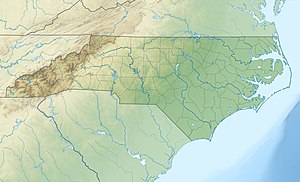| Rocky River Tributary to Pee Dee River | |
|---|---|
 Map of the Pee Dee River watershed showing the Rocky River | |
| Location | |
| Country | United States |
| State | North Carolina |
| County | Anson Cabarrus Iredell Mecklenburg Richmond Stanly Union |
| Physical characteristics | |
| Source | divide between Rocky River and Catawba River |
| • location | Mooresville, North Carolina |
| • coordinates | 35°35′02″N 80°47′54″W / 35.58389°N 80.79833°W[1] |
| • elevation | 885 ft (270 m)[2] |
| Mouth | Pee Dee River |
• location | about 3 miles northeast of Ansonville, North Carolina |
• coordinates | 35°08′36″N 080°04′35″W / 35.14333°N 80.07639°W[1] |
• elevation | 190 ft (58 m)[1] |
| Length | 94.16 mi (151.54 km)[3] |
| Basin size | 1,471.3 sq mi (3,811 km2)[4] |
| Discharge | |
| • location | Pee Dee River |
| • average | 1,526.06 cu ft/s (43.213 m3/s) at mouth with Pee Dee River[4] |
| Basin features | |
| Progression | Pee Dee River → Winyah Bay → Atlantic Ocean |
| River system | Pee Dee River |
| Tributaries | |
| • left | Coddle Creek Irish Buffalo Creek Hamby Branch Dutch Buffalo Creek Little Meadow Creek Meadow Creek Camp Branch Pumpkin Creek Rock Hole Creek Island Creek Coldwater Branch Gilberts Creek Big Bear Creek Murray Branch Stillhouse Branch Spears Branch Coopers Creek Jacks Branch Hardy Creek Big Cedar Creek Little Cedar Creek |
| • right | Dye Creek West Branch Clarke Creek Mallard Creek Back Creek Reedy Creek Bost Creek Anderson Creek Muddy Creek Clear Creek Goose Creek Crooked Creek Grassy Creek Reason Branch Crisco Branch Cedar Branch Richardson Creek Cribs Creek Lanes Creek Little Creek Bowsaw Branch Camp Branch |
The Rocky River is a 95-mile-long (153 km)[5] river in the Piedmont region of North Carolina. It begins in Iredell County near Mooresville and flows south into Cabarrus County, where it is the principal waterway in the county. The river continues southeastward to form the line between Stanly, Union, and Anson counties. It empties into the Pee Dee River just below Norwood, North Carolina at the junction of Stanly, Montgomery, Anson, and Richmond counties, at the foot of the Uwharrie Mountains.
Efforts are being made to boost tourism, including and canoe and kayak recreation, along Rocky River "Blueway" [6] as part of the Carolina Thread Trail.[7][8][9][10][11][12][13][14][15][16]
In 2018, the Hoosier Dam was removed from the Rocky River, reconnecting 253 miles of the upstream aquatic network to 1,100 miles of the downstream, unobstructed aquatic network. This dam removal supported habitats for two federally-listed aquatic species, the Cape Fear Shiner and Harperella[17] and opened new Class I, Class II, and potential Class III rapids on the Rocky River.[18]
Private, non-profit organizations have developed park lands for improved river access, but some controversy ensued.[19][20]
- ^ a b c "GNIS Detail - Rocky River". geonames.usgs.gov. US Geological Survey. Retrieved 13 September 2019.
- ^ "Rocky River Topo Map, Stanly County NC (Mount Gilead West Area)". TopoZone. Locality, LLC. Retrieved 13 September 2019.
- ^ "ArcGIS Web Application". epa.maps.arcgis.com. US EPA. Retrieved 13 September 2019.
- ^ a b "Rocky River Watershed Report". Waters Geoviewer. US EPA. Retrieved 13 September 2019.
- ^ "The National Map". U.S. Geological Survey. Retrieved 14 February 2011.
- ^ "Rocky River Blueway". Carolina Thread Trails. Retrieved 12 March 2019.
- ^ "Anson County tourism boosters tour new kayak and canoe launch at Pee Dee Wildlife Refuge". Anson Record. 22 June 2016. Retrieved 11 March 2019.
- ^ "Editorial: Carolina Thread Trail growing Rowan's way - Salisbury Post". Salisbury Post. 3 December 2014. Retrieved 11 March 2019.
- ^ Kidd, Erin (20 June 2017). "Kathy Kitts: Mother, servant, mayor leaves legacy of caring". The Independent Tribune. Retrieved 11 March 2019.
- ^ "This way, visitors: New signage in Cabarrus guides tourists to attractions". www.bizjournals.com. Retrieved 11 March 2019.
- ^ "Kayak launch opens at Pee Dee Wildlife Refuge". Anson Record. 14 July 2016. Retrieved 12 March 2019.
- ^ "Your Guide to Paddling in North Carolina". ActionHub. Retrieved 12 March 2019.
- ^ Plemmons, Mark (17 September 2018). "Whooping crane spotted in Kannapolis". The Independent Tribune. Retrieved 12 March 2019.
- ^ "Blueway on the Rocky River in southern Cabarrus could boost county's ecotourism traffic". charlotteobserver. Retrieved 12 March 2019.
- ^ Reaves, Tim (20 September 2014). "Midland officially opens Thread Trail 'blueway' on Rocky River". The Independent Tribune. Retrieved 12 March 2019.
- ^ "Ecotourism: Rowin' Down the River". www.cabarrusmagazine.com. Cabarrus Magazine. Retrieved 12 March 2019.
- ^ "Hoosier Dam Removal | Rocky River North Carolina | Unique Places to Save". uniqueplacestosave.org. Retrieved 2024-12-11.
- ^ "Removal of Rocky River dam is a plus for paddlers – Carolina Canoe Club". www.carolinacanoeclub.org. Retrieved 2024-12-11.
- ^ "Land for first Oakboro park purchased 20 years ago - The Stanly News & Press". The Stanly News & Press. 5 August 2018. Retrieved 12 March 2019.
- ^ "Planned Oakboro picnic pavilion sparks parks debate - The Stanly News & Press". The Stanly News & Press. 28 July 2018. Retrieved 12 March 2019.

